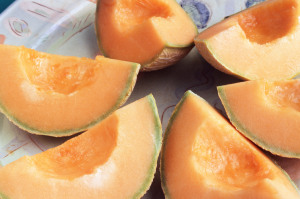 Sweetness, consistency, and juiciness are the characteristics of the ‘Melone Mantovano’. This melon is even more unique thanks to its scent, a pleasant and distinctive mixture of fresh mushroom and pulp of watermelon, with aromas of marrow lime.
Sweetness, consistency, and juiciness are the characteristics of the ‘Melone Mantovano’. This melon is even more unique thanks to its scent, a pleasant and distinctive mixture of fresh mushroom and pulp of watermelon, with aromas of marrow lime.
If its flavour and aroma are immediately involving, its appearance, too, impresses, with spherical and oval shapes, smooth or musk ones, characterized by deep green, practically perfect stripes, as if they were traced, with cream or pale cream colour. Inside, its shades are brilliant, from yellow -orange to salmon. However, the typical colour of this melon is orange, which takes a more or less strong intensity. Its brightness is indicative of an important content in sugars, water, vitamins, and mineral salts. Thanks to its wealth in both simple sugars and nutrients, the melon of Mantua is considered a true well-being supplement for skin and health.
A scented garden
 A document dating back to 1579 bears witness to the presence of an oratory dedicated to ‘St. Mary of the Melon’, in the central ‘Via Cavour’ in Mantua. This oratory was offered by St. Charles Borromeo, who gave it to the Brotherhood of the Holy Cross, turning it into the house dedicated to the ‘Protectress of the Melon’. Also in Mantua, around the late '70s, thanks to the experiments carried out in the Research Centre of the town chemical centre, the first grassy grafting techniques on melon were performed. In 2000, the restoration of the church of Sermide brought to light, on the arch which separates the apse from the presbytery, some decorations in which melons, alongside with onions and pumpkins, appear.
A document dating back to 1579 bears witness to the presence of an oratory dedicated to ‘St. Mary of the Melon’, in the central ‘Via Cavour’ in Mantua. This oratory was offered by St. Charles Borromeo, who gave it to the Brotherhood of the Holy Cross, turning it into the house dedicated to the ‘Protectress of the Melon’. Also in Mantua, around the late '70s, thanks to the experiments carried out in the Research Centre of the town chemical centre, the first grassy grafting techniques on melon were performed. In 2000, the restoration of the church of Sermide brought to light, on the arch which separates the apse from the presbytery, some decorations in which melons, alongside with onions and pumpkins, appear.
The attention shown by scientists and nutritionists, but above all the great care expressed by producers between Emilia- Romagna and Lombardy, led to the acknowledgement of IGP - Protected Geographical Indication by the European Community. This acknowledgement allowed local producers to be able to program a careful policy of brand and export to foreign markets, too.
The area of production of the IGP Melon of Mantua involves a wide area, mainly in the province of Mantua, but also Cremona, Modena, Bologna, and Ferrara. This is a production of excellence, within a context of intensive agriculture which preserves at the most the relationship with this environment. A century-old tradition has proposed the most environmentally friendly strategies in order to preserve the reputation of this fruit, beginning from the total exclusion of products which stimulate ripening. Therefore, ripening happens only naturally. During the growing time, high average temperatures, solar radiation, and low rainfall are reflected on the high sugar content. In order to make this production even more natural, insects for pollination are used: it is forbidden to use any hormonal substance.
Production and marketing
More than 2300 hectares are involved in the production of the melon of Mantua, of which 70% in the open field and 30% in greenhouse. The total production exceeds 70.000 tonnes, which generates an economy of about 65 million Euros. This production involves a mix of large companies oriented to European markets as well as small and medium businesses more oriented to local markets. Switzerland, Germany, Austria, France, Belgium, and Netherlands are the Countries where the melon of Mantua is traditionally exported and meets a huge success. In recent years, Anglo-Saxon and Scandinavian Countries too began to know this unique production.
The Melon of Mantua bets everything on its pleasant appearance and intense scent. It is marketed by using functional packaging in cardboard, wood or plastic, which allow observing and smelling the product. The words ‘Melone Mantovano IGP’ must be perfectly legible both on sealed packages and single fruits. The contents of each package must be uniform and consist in melons of the same variety and category. The brand is built on the basis of a squared circle, where the shape wants to remind that of the melon and the grid refers to the big number of members of the Consortium. Below the words, the most famous profile of the town of Mantua stands out. The colours of the packaging are green and bright orange.
 Typical recipes are sweet and sour salad of melon, ‘risotto’ with melon and the classic summer salads. A typical excellence of Mantua is melon mustard, prepared with the addition of white mustard, a ‘sister’ of the famous mustard of Dijon of French tradition: it is strong and sweet at the same time, and it is especially used for seasoning the famous ‘tortelli di zucca’ (ravioli with pumpkin filling).
Typical recipes are sweet and sour salad of melon, ‘risotto’ with melon and the classic summer salads. A typical excellence of Mantua is melon mustard, prepared with the addition of white mustard, a ‘sister’ of the famous mustard of Dijon of French tradition: it is strong and sweet at the same time, and it is especially used for seasoning the famous ‘tortelli di zucca’ (ravioli with pumpkin filling).
